人教版(2019)必修第一册Welcome Unit Discovering Useful Structures 课件(共41张PPT)
文档属性
| 名称 | 人教版(2019)必修第一册Welcome Unit Discovering Useful Structures 课件(共41张PPT) | 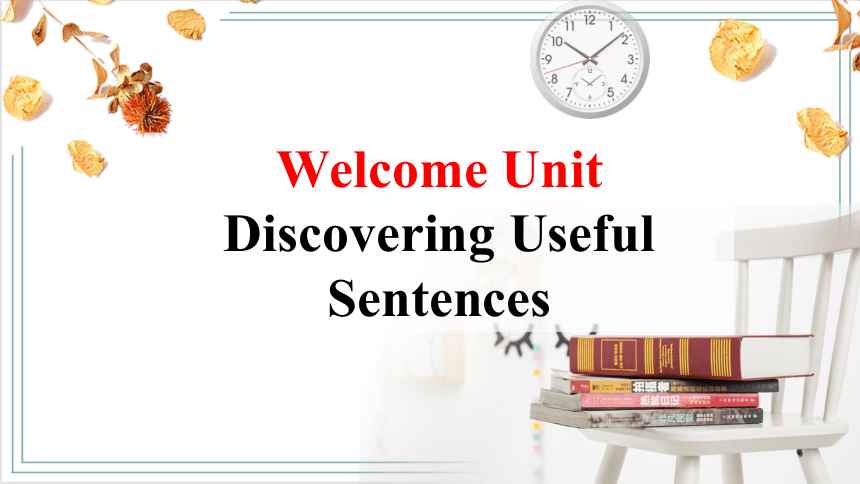 | |
| 格式 | pptx | ||
| 文件大小 | 10.4MB | ||
| 资源类型 | 教案 | ||
| 版本资源 | 人教版(2019) | ||
| 科目 | 英语 | ||
| 更新时间 | 2024-07-29 10:27:35 | ||
图片预览

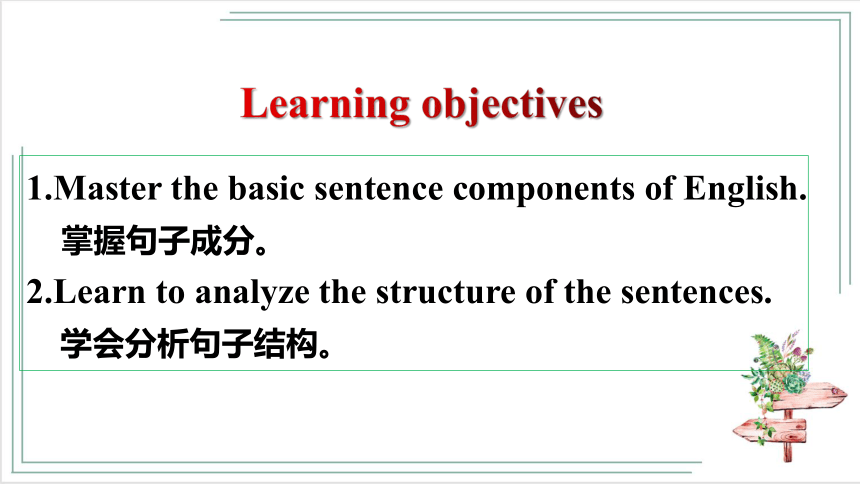
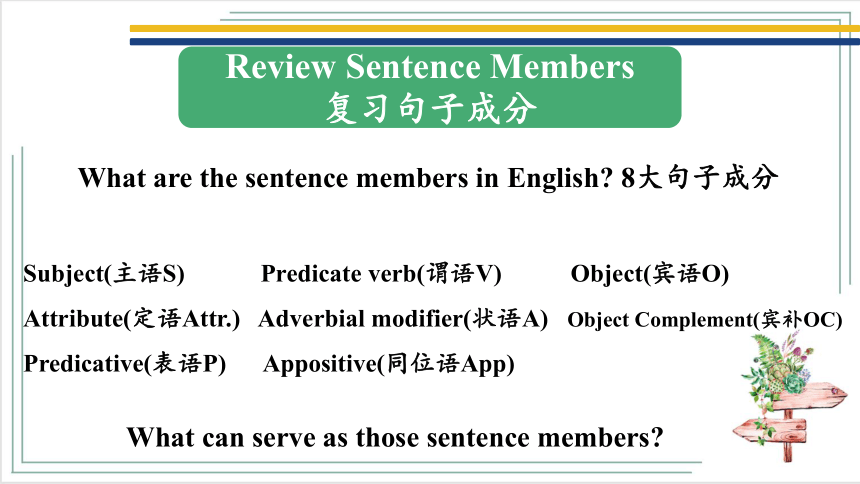
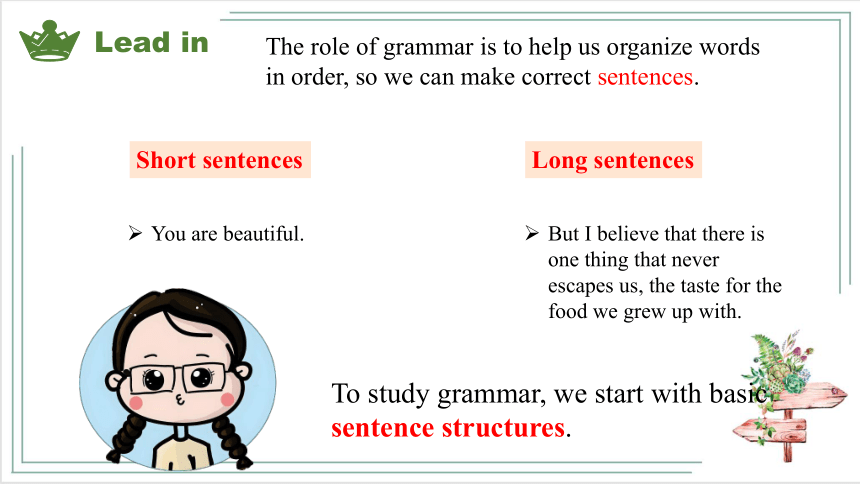
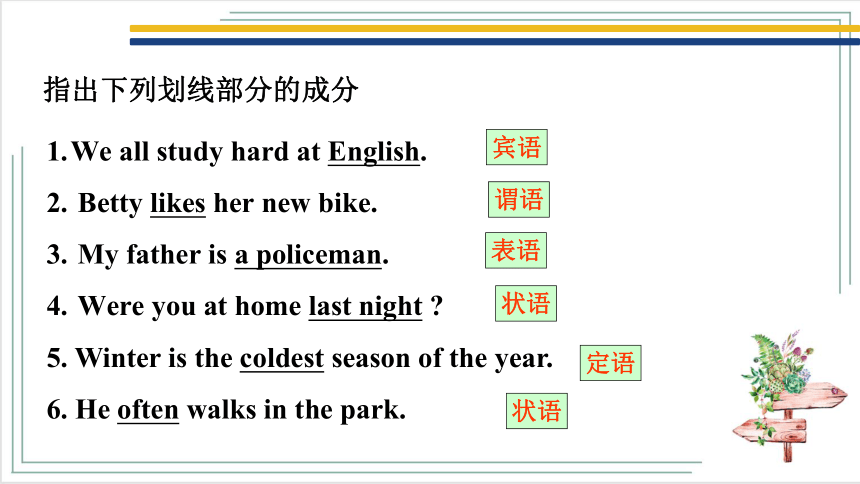
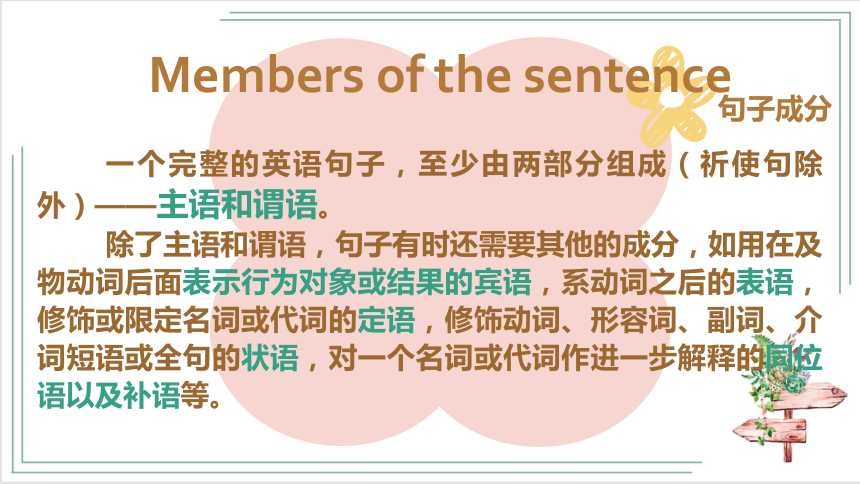
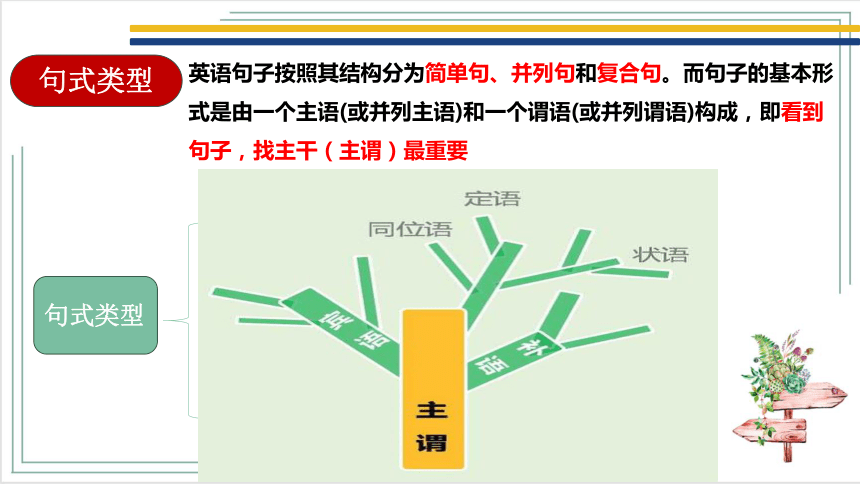
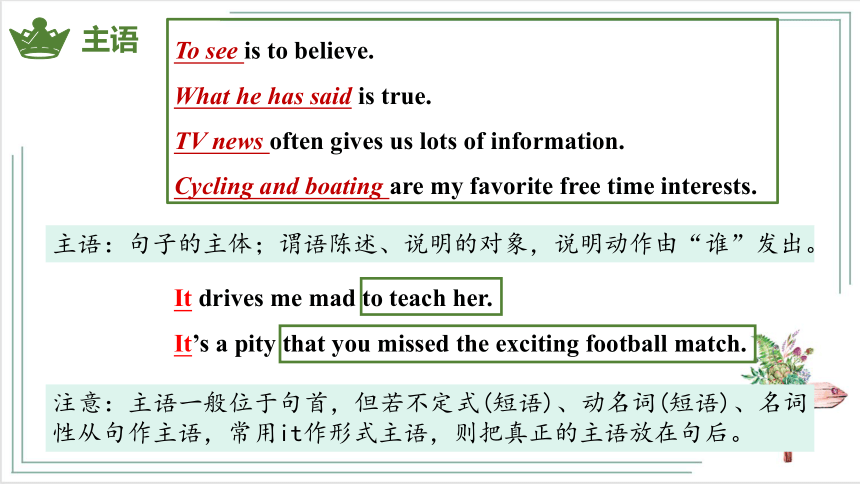
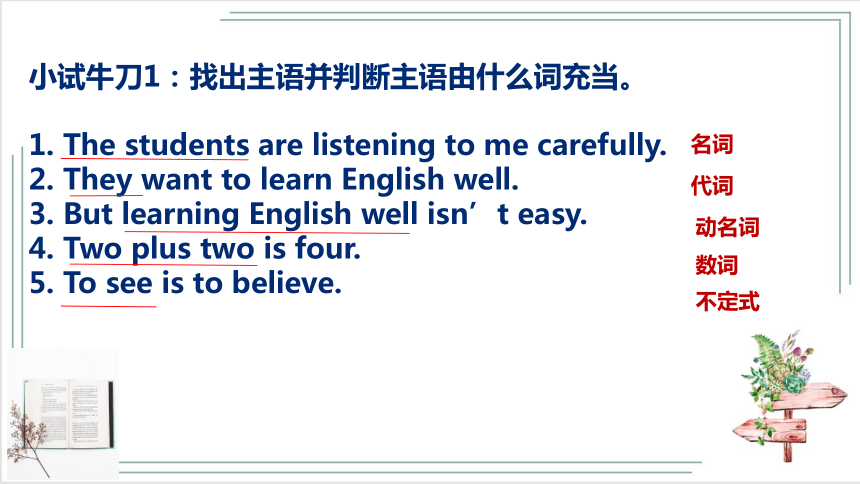
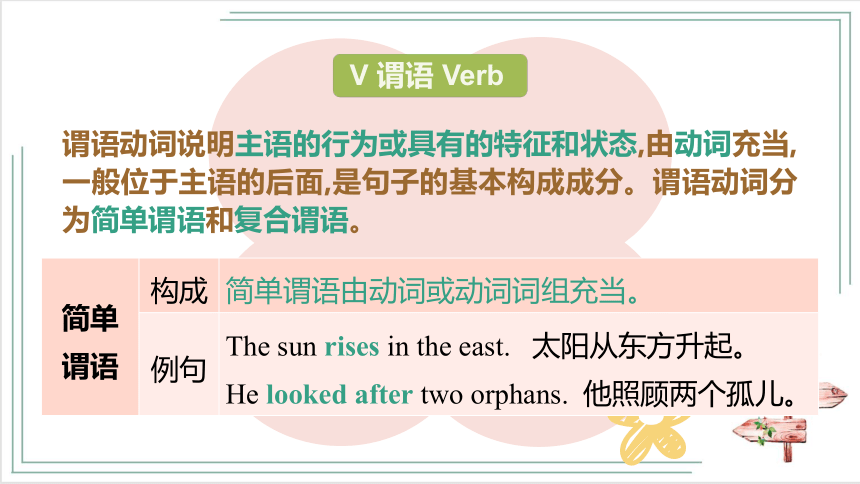
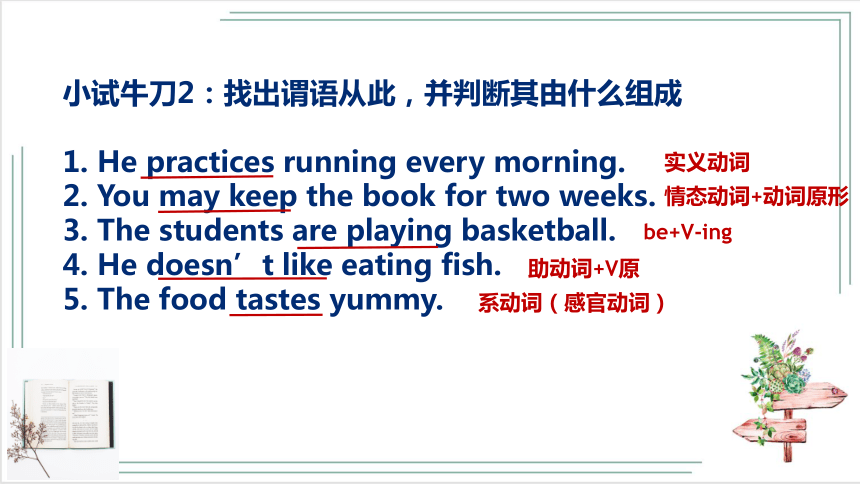
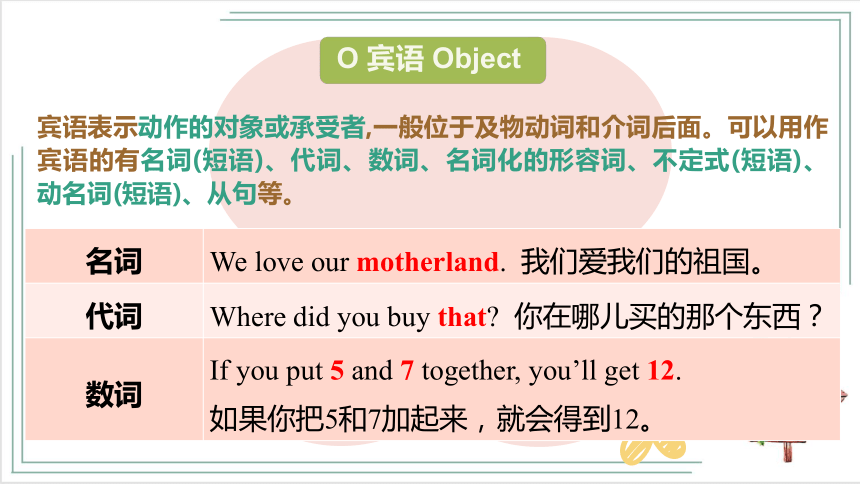
文档简介
(共41张PPT)
Welcome Unit
Discovering Useful Sentences
Learning objectives
1.Master the basic sentence components of English.
掌握句子成分。
2.Learn to analyze the structure of the sentences.
学会分析句子结构。
Review Sentence Members
复习句子成分
What are the sentence members in English 8大句子成分
Subject(主语S) Predicate verb(谓语V) Object(宾语O)
Attribute(定语Attr.) Adverbial modifier(状语A) Object Complement(宾补OC) Predicative(表语P) Appositive(同位语App)
What can serve as those sentence members
Lead in
The role of grammar is to help us organize words in order, so we can make correct sentences.
Short sentences
You are beautiful.
Long sentences
But I believe that there is one thing that never escapes us, the taste for the food we grew up with.
To study grammar, we start with basic sentence structures.
指出下列划线部分的成分
We all study hard at English.
Betty likes her new bike.
My father is a policeman.
Were you at home last night
5. Winter is the coldest season of the year.
6. He often walks in the park.
宾语
谓语
表语
状语
定语
状语
句子成分
Members of the sentence
一个完整的英语句子,至少由两部分组成(祈使句除外)——主语和谓语。
除了主语和谓语,句子有时还需要其他的成分,如用在及物动词后面表示行为对象或结果的宾语,系动词之后的表语,修饰或限定名词或代词的定语,修饰动词、形容词、副词、介词短语或全句的状语,对一个名词或代词作进一步解释的同位语以及补语等。
句式类型
简单句
并列句
复合句
八大句式
简单句
+并列连词(and , but , or)
+简单句
主句+从句
句式类型
英语句子按照其结构分为简单句、并列句和复合句。而句子的基本形式是由一个主语(或并列主语)和一个谓语(或并列谓语)构成,即看到句子,找主干(主谓)最重要
To see is to believe.
What he has said is true.
TV news often gives us lots of information.
Cycling and boating are my favorite free time interests.
主语:句子的主体;谓语陈述、说明的对象,说明动作由“谁”发出。
It drives me mad to teach her.
It’s a pity that you missed the exciting football match.
注意:主语一般位于句首,但若不定式(短语)、动名词(短语)、名词性从句作主语,常用it作形式主语,则把真正的主语放在句后。
主语
小试牛刀1:找出主语并判断主语由什么词充当。
1. The students are listening to me carefully.
2. They want to learn English well.
3. But learning English well isn’t easy.
4. Two plus two is four.
5. To see is to believe.
名词
代词
动名词
数词
不定式
谓语动词说明主语的行为或具有的特征和状态,由动词充当,一般位于主语的后面,是句子的基本构成成分。谓语动词分为简单谓语和复合谓语。
简单谓语 构成 简单谓语由动词或动词词组充当。
例句 The sun rises in the east. 太阳从东方升起。
He looked after two orphans. 他照顾两个孤儿。
V 谓语 Verb
小试牛刀2:找出谓语从此,并判断其由什么组成
1. He practices running every morning.
2. You may keep the book for two weeks.
3. The students are playing basketball.
4. He doesn’t like eating fish.
5. The food tastes yummy.
实义动词
情态动词+动词原形
be+V-ing
助动词+V原
系动词(感官动词)
宾语表示动作的对象或承受者,一般位于及物动词和介词后面。可以用作宾语的有名词(短语)、代词、数词、名词化的形容词、不定式(短语)、动名词(短语)、从句等。
O 宾语 Object
名词 We love our motherland. 我们爱我们的祖国。
代词 Where did you buy that 你在哪儿买的那个东西?
数词 If you put 5 and 7 together, you’ll get 12.
如果你把5和7加起来,就会得到12。
小试牛刀3:找出宾语并判断其由什么词充当。
1.He is going to buy a dictionary.
2.We should learn from him.
3.-How many do you want -I want two.
4.I like swimming.
5. Do you know what he said
名词
代词
数词
动名词
宾语从句
My mom made me a cake.
My mom made a cake for me.
S
V
DO
IO
S
V
DO
IO
My mom made me happy.
S
V
O
OC 宾补
区分以下句子成分:宾补?双宾语?
My mom made me a fool.
S
V
O
OC 宾补
Study Sentence Structures
Please observe the four sentences, underline the sentence members of each sentence.观察句子,找出句子成分
1. The rain has stopped.
2. She feels much more confident now.
3. She will make new friends.
4. There’s a lot to explore at senior high school. 什么句型?
S V
S V P
S V O
There be句型... 真正主语
Observe the sentences below and study its sentence structures.
观察以下句子,分析句子成分
Observe and Find
Sentence structure Sentence
SV All of us laughed!
SVO I miss my grandma.
SVP The teacher was kind and friendly
S V IO DO He told us a funny story.
SVOC I found most of my classmates and teachers friendly and helpful.
SVA He talked too much.
SVOA I had my first maths class at senior high school.
There be … There’s a lot to explore at senior high.
名词 Pollution from cars has become a major problem.
来自汽车的污染已成了一个主要问题。
代词 Seventy-four! You don’t look it. 七十四啦!你看起来不像。
数词 Angela was the first to leave. 安吉拉是第一个走的。
形容词 Please feel free to say what you really think. 请随便谈谈你的真实想法吧。
动名词(短语) Wasting time is killing yourself. 浪费时间就是自杀。
说明主语的性质、特征、身份或状态,与连系动词be , look, seem , appear , feel , taste , smell, sound , become , get, grow, turn, remain, keep, stay 等一起构成复合谓语。表语通常由名词(短语)代词、形容词、数词、副词、介词短语、不定式(短语)、动名词(短语)、分(短语)或从句等充当。
P 表语 Predicative
小试牛刀4:找出表语语并判断其由什么词充当。
1. Our teacher of English is an American.
2. Is it yours
3. The weather has turned cold.
4. Five plus two is seven.
5. My hobby is reading.
6. Our duty is to make our environment better.
名词
代词
形容词
数词
动名词
不定式
修饰或限定名词或代词的成分叫做定语,分为前置定语和后置定语两种。一般由形容词、代词、数词、名词或名词所有格、副词、介词短语、不定式(短语)、分词(短语)或从句等充当。
Att 定语 Attributive
形容词 It’s a fine day today. 今天天气晴朗。
代词 Open your mouth and put out your tongue. 张开嘴,伸出舌头。
数词 She cut the cake into two pieces. 她把蛋糕切成了两块。
名词 This is a stone table. 这是一张石头桌子。
副词 The buildings around were badly damaged. 周围的楼房都被严重损坏了。
小试牛刀5:找出定语并判断其由什么词充当。
1.Beijing is a beautiful city.
2.They are building a stone bridge.
3.There are 54 students in our class.
4.Do you known Betty's sister
5.He bought some sleeping pills.
6.His spoken language is good.
(形容词)
(名词)
(数词)
(名词的所有格)
(动名词)
(过去分词)
The 100-year-old school lies in the centre of the city.
2. We must act.
3. The maths homework looks easy.
4. The teacher found the classroom empty.
S
V
A
S
S
S
V
V
V P
O
OC
Read the sentences and analyse the structures.读析句子结构
5. My mum bought me a new dictionary.
6. Tom is looking forward to meeting the new exchange student.
7. There is an English Corner at our school.
8. We had chemistry in the newly built lab.
S
V
IO
DO
S
V
O
There be句型...
S
V
O
A
Read the sentences and analyse the structures.读析句子结构
I will be back in a while.
He was late because he got up late.
He got up so late that he missed the train.
In order to catch up with the others, I must work harder.
状语:说明动作何时、何地、如何发生;说明形容词或副词的程度。用于修饰形容词,副词,动词或句子。位置自由自在。
类型:表示时间,地点,原因,结果,目的,方式,伴随,条件,程度,让步,频率等。
状语 Adverbial
小试牛刀6:找出状语
1. He speaks English very well.
2. They drove carefully in the rain.
2. I come specially to see you.
3. She usually gets up at seven in the morning.
4. If I am not busy tomorrow, I will play football with you.
宾语补足语是用来说明宾语的性质、状态等的一种句子成分。宾语和宾语补足语构成了复合宾语,它们在逻辑上有主谓关系。名词(短语)、形容词(短语)、副词、介词短语、不定式(短语)、分词(短语)等皆可作补足语。
C 宾语补足语 Object Complement
形容词 I found the book very interesting. 我觉得这本书很有意思。
分词(短语) He made himself known to them first. 他先向他们作了自我介绍。
不定式(短语) She asked me to lend her a hand. 她请我帮她一把。
句子类型
句子类型有分三种:简单句、并列句和复合句。
1、简单句(simple sentence): 1个主语+n个谓语 或 n个主语+1个谓语
eg.1.He is a boy.
2.She and he will go there.
3、复合句(complex sentence): 简单句+从句(见导与练第9页)
eg. 1.The boy who is standing under the tree is my brother.(定语从句)
2.Who will go is not important.(主语从句)
2、并列句(compound sentence): 简单句+并列连词+简单句(见导与练第9页)
eg. 1.He is a boy and she is a girl.
2.It is raining, so I wear my coat.
基本句型 一
S(subject) +V(verb)(主+谓)
特点:句子的谓语动词都能表达完整的意思。
这类动词叫做不及物动词,后面可以跟副词、介词短语、状语从句等。即:后面不可以直接跟宾语,但可以加介词再加宾语
主语+谓语 SV
V是指不及物动词
Things changed.
情况有了变化。
The bell has rung.
铃声响过了。
绝大多数及物动词都是只带一个宾语的动词
主语+谓语+宾语 SVO
Farmers in our county grow all kinds of vegetables.
我们县的农民种植各种各样的蔬菜。
基本句型 二
S +V +P(主+系+表)
此句型的句子有一个共同的特点:句子的系动词都不能表达一个完整的意思,必须加上一个表明主语身份或状
态的表语,才能表达完整的意思。表语多为形容词,也可以是名词、介词短语、动名词等。
主语+谓语+表语 SVP
谓语动词为连系动词
The weather is becoming colder and colder.
天气变得越来越冷
IO 为间接宾语,DO为直接宾语。
The rescued miner told us a lot about their adventure.
被营救的矿工告诉了我们很多他们的冒险经历。
主语+谓语+间接宾语+直接宾语 S V IO DO
基本句型 三
S +V +O(主+谓+宾)
特点:宾语表示动作的对象或行为的承受者,一般位于及物动词(短语)和介词后面,一般由名词、代词、数词、动词不定式(短语)、动名词(短语)等充当。
主谓宾结构:主语+谓语+宾语
此句型中的谓语必须是 或及物动词短语,一般有被动语态。用作宾语的有名词、代词、数词、不定式、动名词或从句等。
I want to have a cup of tea.
Students have different opinions.
Our school will hold a sports meet.
The students have known the answer.
及物动词
注意:在“动词+介词”的动词短语中,宾语只能跟在介词之后;在“动词+副词”的动词短语中,作宾语的名词放在副词前、后皆可,而作宾语的代词只能放在副词之前。
Please wake Li Ling up
(=wake up Li Ling).(√)
Please wake her up.(√)
Please wake up her.(×)
基本句型 四
S +V +IO +DO(主+谓+间宾+直宾)
此句型的句子有一个共同特点:谓语动词后面必须有两个宾语才能表达完整的意思。这两个宾语一个是动作的直接承受者(物),另一个是动作的间接承受者(人)。
主谓宾宾结构: 主语+谓语+间接宾语+直接宾语
He bought me a birthday present.
I showed him my pictures.
I remember you showed me some photos on that theme.
Besides, nothing could be better if you could offer me some information.
此句型中的及物动词后跟双宾语,指人的宾语称为间接宾语,指物的宾语称为直接宾语。通常间接宾语在前,直接宾语在后,也可把间接宾语置于直接宾语后,但间接宾语前需用介词for或to。
间接宾语后置与for连用的动词有: buy、fetch、save、choose、sing等。
间接宾语后置与to连用的动词有:give、tell、teach、write、bring、lend、hand、show、offer、send、pay、order等。
基本句型 五
S +V +O +C(主+谓+宾+宾补)
此句型的句子的共同特点是:动词虽然是及物动词,但是只跟一个宾语还不能表达完整的意思,必须加上一个补充成分来补足宾语,才能使意思完整。
主谓宾补结构:主语+谓语+宾语+宾语补足语
Mike told me not to go.
The news made everyone of us very happy.
She asked the students their names.
We all heard him reading English aloud.
此句型的句子的共同特点是:动词虽然是及物动词,但是只跟一个宾语还不能表达完整的意思,必须加上一个补充成分来补足宾语,才能使意思完整。
常见能够接宾补的动词有:
使役动词:keep, make, let, have, leave, get等;
感官动词或短语:see, watch, notice, observe, find, catch, look at, listen to, hear, feel, smell等;
后跟带to的不定式作宾语补足语的动词:ask, tell, order, request, permit, persuade等。
主语+谓语+状语 SVA
She always walks fast.她总是走路很快。
谓语是不及物动词
主语+谓语+宾语+状语 SVOA
谓语是及物动词
Mary put her book on the desk.
玛丽把书放在桌子上。
翻译练习:
1. 他们走着,笑着。
2. 语文老师很友好。
3. 树上有一只可爱的小鸟。
4. 他给她妹妹买了一架钢琴。
5. 老师发现教室是空的。
They walked and laughed.
The Chinese teacher is friendly.
There is a lovely bird in the tree.
He bought his sister a piano.
The teacher found the classroom empty.
How would you like to go to school and travel the world at the same time For Tim, that dream has come true! This term, Tim and his classmates are living on a ship! They take the same subjects as you do, like maths and English. They also learn about ships and the sea. Tim writes his parents and email every week and tells them what happened on the ship. Tim loves living on the ship. There’s always something exciting to do. And, after a long day study, he likes to watch the sun go down and wait for the stars to come out. Studying and doing homework seem much more fun when you are at sea!
Read the passage and analyse the structures of the underlined sentences.
阅读文章,分析画线部分句子结构
SV
SVA
SVO
S V IO DO A
There be...
SVP
V IO DO A
翻译练习:
6. 我听到她正在唱歌。
7. 英语作业看上去很简单。
8. 我们笑得很开心。
9. 我们学校有许多学生。
10. 她是一个爱交际的女孩。
I heard her singing a song.
The English homework looks easy.
We laugh happily.
There are many students in our school.
She is an outgoing girl.
1.She is fond of various kinds of fruits and vegetables.
她喜欢各种各样的水果和蔬菜
2.We usually get up at seven o’clock and have a brief breakfast before going to school.
3.The man who returned my wallet is called Simon.
这个归还我钱包的男士叫西蒙
4.My father bought me a lot of books,hoping to improve my reading comprehension.
我爸爸给我买了许多书,希望我提升阅读理解能力
5.He is one of my neighbours and we are good friends.
他是我的一个邻居,而且,我们还是好朋友
6.My sister got interested in painting when she was very young.
当我妹妹小的时候,她就对画画很感兴趣
Write question 10 here
tekhnologic
1
2
3
4
5
6
Practice 气球游戏:回答问题,正确可奖励全班鼓掌一次,错误只得勉励鼓掌一次。
判断句子类型
提示:简单句
并列句
复合句
Welcome Unit
Discovering Useful Sentences
Learning objectives
1.Master the basic sentence components of English.
掌握句子成分。
2.Learn to analyze the structure of the sentences.
学会分析句子结构。
Review Sentence Members
复习句子成分
What are the sentence members in English 8大句子成分
Subject(主语S) Predicate verb(谓语V) Object(宾语O)
Attribute(定语Attr.) Adverbial modifier(状语A) Object Complement(宾补OC) Predicative(表语P) Appositive(同位语App)
What can serve as those sentence members
Lead in
The role of grammar is to help us organize words in order, so we can make correct sentences.
Short sentences
You are beautiful.
Long sentences
But I believe that there is one thing that never escapes us, the taste for the food we grew up with.
To study grammar, we start with basic sentence structures.
指出下列划线部分的成分
We all study hard at English.
Betty likes her new bike.
My father is a policeman.
Were you at home last night
5. Winter is the coldest season of the year.
6. He often walks in the park.
宾语
谓语
表语
状语
定语
状语
句子成分
Members of the sentence
一个完整的英语句子,至少由两部分组成(祈使句除外)——主语和谓语。
除了主语和谓语,句子有时还需要其他的成分,如用在及物动词后面表示行为对象或结果的宾语,系动词之后的表语,修饰或限定名词或代词的定语,修饰动词、形容词、副词、介词短语或全句的状语,对一个名词或代词作进一步解释的同位语以及补语等。
句式类型
简单句
并列句
复合句
八大句式
简单句
+并列连词(and , but , or)
+简单句
主句+从句
句式类型
英语句子按照其结构分为简单句、并列句和复合句。而句子的基本形式是由一个主语(或并列主语)和一个谓语(或并列谓语)构成,即看到句子,找主干(主谓)最重要
To see is to believe.
What he has said is true.
TV news often gives us lots of information.
Cycling and boating are my favorite free time interests.
主语:句子的主体;谓语陈述、说明的对象,说明动作由“谁”发出。
It drives me mad to teach her.
It’s a pity that you missed the exciting football match.
注意:主语一般位于句首,但若不定式(短语)、动名词(短语)、名词性从句作主语,常用it作形式主语,则把真正的主语放在句后。
主语
小试牛刀1:找出主语并判断主语由什么词充当。
1. The students are listening to me carefully.
2. They want to learn English well.
3. But learning English well isn’t easy.
4. Two plus two is four.
5. To see is to believe.
名词
代词
动名词
数词
不定式
谓语动词说明主语的行为或具有的特征和状态,由动词充当,一般位于主语的后面,是句子的基本构成成分。谓语动词分为简单谓语和复合谓语。
简单谓语 构成 简单谓语由动词或动词词组充当。
例句 The sun rises in the east. 太阳从东方升起。
He looked after two orphans. 他照顾两个孤儿。
V 谓语 Verb
小试牛刀2:找出谓语从此,并判断其由什么组成
1. He practices running every morning.
2. You may keep the book for two weeks.
3. The students are playing basketball.
4. He doesn’t like eating fish.
5. The food tastes yummy.
实义动词
情态动词+动词原形
be+V-ing
助动词+V原
系动词(感官动词)
宾语表示动作的对象或承受者,一般位于及物动词和介词后面。可以用作宾语的有名词(短语)、代词、数词、名词化的形容词、不定式(短语)、动名词(短语)、从句等。
O 宾语 Object
名词 We love our motherland. 我们爱我们的祖国。
代词 Where did you buy that 你在哪儿买的那个东西?
数词 If you put 5 and 7 together, you’ll get 12.
如果你把5和7加起来,就会得到12。
小试牛刀3:找出宾语并判断其由什么词充当。
1.He is going to buy a dictionary.
2.We should learn from him.
3.-How many do you want -I want two.
4.I like swimming.
5. Do you know what he said
名词
代词
数词
动名词
宾语从句
My mom made me a cake.
My mom made a cake for me.
S
V
DO
IO
S
V
DO
IO
My mom made me happy.
S
V
O
OC 宾补
区分以下句子成分:宾补?双宾语?
My mom made me a fool.
S
V
O
OC 宾补
Study Sentence Structures
Please observe the four sentences, underline the sentence members of each sentence.观察句子,找出句子成分
1. The rain has stopped.
2. She feels much more confident now.
3. She will make new friends.
4. There’s a lot to explore at senior high school. 什么句型?
S V
S V P
S V O
There be句型... 真正主语
Observe the sentences below and study its sentence structures.
观察以下句子,分析句子成分
Observe and Find
Sentence structure Sentence
SV All of us laughed!
SVO I miss my grandma.
SVP The teacher was kind and friendly
S V IO DO He told us a funny story.
SVOC I found most of my classmates and teachers friendly and helpful.
SVA He talked too much.
SVOA I had my first maths class at senior high school.
There be … There’s a lot to explore at senior high.
名词 Pollution from cars has become a major problem.
来自汽车的污染已成了一个主要问题。
代词 Seventy-four! You don’t look it. 七十四啦!你看起来不像。
数词 Angela was the first to leave. 安吉拉是第一个走的。
形容词 Please feel free to say what you really think. 请随便谈谈你的真实想法吧。
动名词(短语) Wasting time is killing yourself. 浪费时间就是自杀。
说明主语的性质、特征、身份或状态,与连系动词be , look, seem , appear , feel , taste , smell, sound , become , get, grow, turn, remain, keep, stay 等一起构成复合谓语。表语通常由名词(短语)代词、形容词、数词、副词、介词短语、不定式(短语)、动名词(短语)、分(短语)或从句等充当。
P 表语 Predicative
小试牛刀4:找出表语语并判断其由什么词充当。
1. Our teacher of English is an American.
2. Is it yours
3. The weather has turned cold.
4. Five plus two is seven.
5. My hobby is reading.
6. Our duty is to make our environment better.
名词
代词
形容词
数词
动名词
不定式
修饰或限定名词或代词的成分叫做定语,分为前置定语和后置定语两种。一般由形容词、代词、数词、名词或名词所有格、副词、介词短语、不定式(短语)、分词(短语)或从句等充当。
Att 定语 Attributive
形容词 It’s a fine day today. 今天天气晴朗。
代词 Open your mouth and put out your tongue. 张开嘴,伸出舌头。
数词 She cut the cake into two pieces. 她把蛋糕切成了两块。
名词 This is a stone table. 这是一张石头桌子。
副词 The buildings around were badly damaged. 周围的楼房都被严重损坏了。
小试牛刀5:找出定语并判断其由什么词充当。
1.Beijing is a beautiful city.
2.They are building a stone bridge.
3.There are 54 students in our class.
4.Do you known Betty's sister
5.He bought some sleeping pills.
6.His spoken language is good.
(形容词)
(名词)
(数词)
(名词的所有格)
(动名词)
(过去分词)
The 100-year-old school lies in the centre of the city.
2. We must act.
3. The maths homework looks easy.
4. The teacher found the classroom empty.
S
V
A
S
S
S
V
V
V P
O
OC
Read the sentences and analyse the structures.读析句子结构
5. My mum bought me a new dictionary.
6. Tom is looking forward to meeting the new exchange student.
7. There is an English Corner at our school.
8. We had chemistry in the newly built lab.
S
V
IO
DO
S
V
O
There be句型...
S
V
O
A
Read the sentences and analyse the structures.读析句子结构
I will be back in a while.
He was late because he got up late.
He got up so late that he missed the train.
In order to catch up with the others, I must work harder.
状语:说明动作何时、何地、如何发生;说明形容词或副词的程度。用于修饰形容词,副词,动词或句子。位置自由自在。
类型:表示时间,地点,原因,结果,目的,方式,伴随,条件,程度,让步,频率等。
状语 Adverbial
小试牛刀6:找出状语
1. He speaks English very well.
2. They drove carefully in the rain.
2. I come specially to see you.
3. She usually gets up at seven in the morning.
4. If I am not busy tomorrow, I will play football with you.
宾语补足语是用来说明宾语的性质、状态等的一种句子成分。宾语和宾语补足语构成了复合宾语,它们在逻辑上有主谓关系。名词(短语)、形容词(短语)、副词、介词短语、不定式(短语)、分词(短语)等皆可作补足语。
C 宾语补足语 Object Complement
形容词 I found the book very interesting. 我觉得这本书很有意思。
分词(短语) He made himself known to them first. 他先向他们作了自我介绍。
不定式(短语) She asked me to lend her a hand. 她请我帮她一把。
句子类型
句子类型有分三种:简单句、并列句和复合句。
1、简单句(simple sentence): 1个主语+n个谓语 或 n个主语+1个谓语
eg.1.He is a boy.
2.She and he will go there.
3、复合句(complex sentence): 简单句+从句(见导与练第9页)
eg. 1.The boy who is standing under the tree is my brother.(定语从句)
2.Who will go is not important.(主语从句)
2、并列句(compound sentence): 简单句+并列连词+简单句(见导与练第9页)
eg. 1.He is a boy and she is a girl.
2.It is raining, so I wear my coat.
基本句型 一
S(subject) +V(verb)(主+谓)
特点:句子的谓语动词都能表达完整的意思。
这类动词叫做不及物动词,后面可以跟副词、介词短语、状语从句等。即:后面不可以直接跟宾语,但可以加介词再加宾语
主语+谓语 SV
V是指不及物动词
Things changed.
情况有了变化。
The bell has rung.
铃声响过了。
绝大多数及物动词都是只带一个宾语的动词
主语+谓语+宾语 SVO
Farmers in our county grow all kinds of vegetables.
我们县的农民种植各种各样的蔬菜。
基本句型 二
S +V +P(主+系+表)
此句型的句子有一个共同的特点:句子的系动词都不能表达一个完整的意思,必须加上一个表明主语身份或状
态的表语,才能表达完整的意思。表语多为形容词,也可以是名词、介词短语、动名词等。
主语+谓语+表语 SVP
谓语动词为连系动词
The weather is becoming colder and colder.
天气变得越来越冷
IO 为间接宾语,DO为直接宾语。
The rescued miner told us a lot about their adventure.
被营救的矿工告诉了我们很多他们的冒险经历。
主语+谓语+间接宾语+直接宾语 S V IO DO
基本句型 三
S +V +O(主+谓+宾)
特点:宾语表示动作的对象或行为的承受者,一般位于及物动词(短语)和介词后面,一般由名词、代词、数词、动词不定式(短语)、动名词(短语)等充当。
主谓宾结构:主语+谓语+宾语
此句型中的谓语必须是 或及物动词短语,一般有被动语态。用作宾语的有名词、代词、数词、不定式、动名词或从句等。
I want to have a cup of tea.
Students have different opinions.
Our school will hold a sports meet.
The students have known the answer.
及物动词
注意:在“动词+介词”的动词短语中,宾语只能跟在介词之后;在“动词+副词”的动词短语中,作宾语的名词放在副词前、后皆可,而作宾语的代词只能放在副词之前。
Please wake Li Ling up
(=wake up Li Ling).(√)
Please wake her up.(√)
Please wake up her.(×)
基本句型 四
S +V +IO +DO(主+谓+间宾+直宾)
此句型的句子有一个共同特点:谓语动词后面必须有两个宾语才能表达完整的意思。这两个宾语一个是动作的直接承受者(物),另一个是动作的间接承受者(人)。
主谓宾宾结构: 主语+谓语+间接宾语+直接宾语
He bought me a birthday present.
I showed him my pictures.
I remember you showed me some photos on that theme.
Besides, nothing could be better if you could offer me some information.
此句型中的及物动词后跟双宾语,指人的宾语称为间接宾语,指物的宾语称为直接宾语。通常间接宾语在前,直接宾语在后,也可把间接宾语置于直接宾语后,但间接宾语前需用介词for或to。
间接宾语后置与for连用的动词有: buy、fetch、save、choose、sing等。
间接宾语后置与to连用的动词有:give、tell、teach、write、bring、lend、hand、show、offer、send、pay、order等。
基本句型 五
S +V +O +C(主+谓+宾+宾补)
此句型的句子的共同特点是:动词虽然是及物动词,但是只跟一个宾语还不能表达完整的意思,必须加上一个补充成分来补足宾语,才能使意思完整。
主谓宾补结构:主语+谓语+宾语+宾语补足语
Mike told me not to go.
The news made everyone of us very happy.
She asked the students their names.
We all heard him reading English aloud.
此句型的句子的共同特点是:动词虽然是及物动词,但是只跟一个宾语还不能表达完整的意思,必须加上一个补充成分来补足宾语,才能使意思完整。
常见能够接宾补的动词有:
使役动词:keep, make, let, have, leave, get等;
感官动词或短语:see, watch, notice, observe, find, catch, look at, listen to, hear, feel, smell等;
后跟带to的不定式作宾语补足语的动词:ask, tell, order, request, permit, persuade等。
主语+谓语+状语 SVA
She always walks fast.她总是走路很快。
谓语是不及物动词
主语+谓语+宾语+状语 SVOA
谓语是及物动词
Mary put her book on the desk.
玛丽把书放在桌子上。
翻译练习:
1. 他们走着,笑着。
2. 语文老师很友好。
3. 树上有一只可爱的小鸟。
4. 他给她妹妹买了一架钢琴。
5. 老师发现教室是空的。
They walked and laughed.
The Chinese teacher is friendly.
There is a lovely bird in the tree.
He bought his sister a piano.
The teacher found the classroom empty.
How would you like to go to school and travel the world at the same time For Tim, that dream has come true! This term, Tim and his classmates are living on a ship! They take the same subjects as you do, like maths and English. They also learn about ships and the sea. Tim writes his parents and email every week and tells them what happened on the ship. Tim loves living on the ship. There’s always something exciting to do. And, after a long day study, he likes to watch the sun go down and wait for the stars to come out. Studying and doing homework seem much more fun when you are at sea!
Read the passage and analyse the structures of the underlined sentences.
阅读文章,分析画线部分句子结构
SV
SVA
SVO
S V IO DO A
There be...
SVP
V IO DO A
翻译练习:
6. 我听到她正在唱歌。
7. 英语作业看上去很简单。
8. 我们笑得很开心。
9. 我们学校有许多学生。
10. 她是一个爱交际的女孩。
I heard her singing a song.
The English homework looks easy.
We laugh happily.
There are many students in our school.
She is an outgoing girl.
1.She is fond of various kinds of fruits and vegetables.
她喜欢各种各样的水果和蔬菜
2.We usually get up at seven o’clock and have a brief breakfast before going to school.
3.The man who returned my wallet is called Simon.
这个归还我钱包的男士叫西蒙
4.My father bought me a lot of books,hoping to improve my reading comprehension.
我爸爸给我买了许多书,希望我提升阅读理解能力
5.He is one of my neighbours and we are good friends.
他是我的一个邻居,而且,我们还是好朋友
6.My sister got interested in painting when she was very young.
当我妹妹小的时候,她就对画画很感兴趣
Write question 10 here
tekhnologic
1
2
3
4
5
6
Practice 气球游戏:回答问题,正确可奖励全班鼓掌一次,错误只得勉励鼓掌一次。
判断句子类型
提示:简单句
并列句
复合句
